
The economy of fishing among the traditional fisherfolk of Kerala is based on three operations such as harvesting or catching of the fish, the processing of fish and the marketing of fish. The catching of the fish is dependant on the technology used for fishing as well as the relationships between the all those who are involved in production (Aerthayil, 2000).
The fishing techniques in Kerala are very old and the Kerala fishermen are well known to be experts in the skills of fishing with their greatest asset being the knowledge of fish, fish habits, waves, currents and stars. Kurien (1985) writes that this knowledge is extremely valuable for the fishermen and is handed down from generation to generation.
 A fishing harbour near the fishing village (Photo: Aarti Kelkar-Khambete)
A fishing harbour near the fishing village (Photo: Aarti Kelkar-Khambete)
Technology used for fishing
The technology used among the traditional fisherfolk of Kerala for catching fish such as the fishing craft and the gear are traditionally evolved and differ according to the needs of the specific local fishing conditions. For example, the south has multi specied and dispersed fishery, which requires multiple gears. The fishermen in this area mainly use the traditional boat called as the Catamaram while going out individually, in pairs or in groups of three (Houtart and Nayak, 1988).
The Catamaram
The Catamaram is made up of two or three logs of wood tied together with coir ropes. The rope is tied around a cross piece of wood in the shape of stumped bull horns placed at the end of the logs. Small gaps are purposefully left in-between the logs to allow the water to drain thus reducing the impact of waves (Ram, 1991). There are two types of Catamarams. One is smaller with a crew size of two and is used for hook and line fishing such as anchovy, sardine and the prawn nets. Hook and line fishing is more common in the south because of multispecied and dispersed fishing (Ram, 1991, Bhushan, 1979).
In the hook and line fishing, the gear is made of a hook with a line attached to it. The bait lures the fish. The fish gets caught in the barb while attempting to eat the bait and cannot free itself. The gear is very selective in action in catching different species and different sizes of fish. The hook is very important and the size of the hook, the type of the hook used, the type of bait used determines the selectivity of the catch (Shrivastava, 1985)
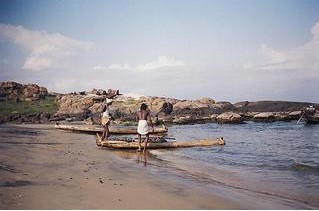 Fishermen with their catamaram (Photo: Aarti Kelkar- Khambete)
Fishermen with their catamaram (Photo: Aarti Kelkar- Khambete)
The larger Catamarams can accommodate 3 to 4 persons and are used in pairs with bell shaped nets (boat seine nets or Tattamadi) having ropes on either side. Two crafts pull the ropes at equidistant angles. On seeing a shoal of fish, the two crafts start moving in the direction of the shoal pulling the ropes and sandwiching the shoal between the two crafts (Iyengar, 1985; Ram, 1991).
The Vallam
Another type of a small boat or plank canoe called Vallam is also used for fishing from the shore. It is made up by seaming together several planks of jungle jack by coir ropes. The inside of the boat is coated with pitch to make it watertight (Ram, 1991). There are two types of Vallam. Kettu Vallam is the smaller one and is owned jointly by 6 to 12 fishermen. It is popularly used for hook and line fishing in Trivandrum and Alleppey districts (Iyengar, 1985).
Ottathadi Vallam is a dugout canoe between 10 to 15 metres long, carrying upto 15 members. It is made by scooping out large logs of softwood such as jungle jack or mango. These are owned collectively (Iyengar, 1985). Houtart and Nayak (1988) inform that majority of the fishermen in the South are thus self employed, but there are a few fishermen who remain coolies or labourers all throughout their lives.
The fishermen in the central region of Kerala use larger crafts and gears because of the presence of sand banks and rich fishing grounds. The fishermen here work together in groups. The north has single specied fishing and the craft and the gears used are larger. Houtart and Nayak (1988) write that this has led to polarisation between the big and the small artisenal fishworkers, where the small fishworkers resort to hook and line fishing while others survive as labourers.
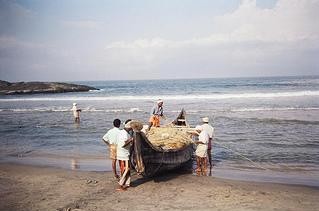
Fishermen with their vallam (Photo: Aarti Kelkar - Khambete)
The activity of fishing
An observation of the activities taking place on the coast of Trivandrum city, while the fishermen set out for fishing and then returning with their catch from the sea is very exciting and interesting indicating a flurry of activity. The traditional fishermen along the coastal areas of Trivandrum use the Catamaram, which is either used individually or in pairs. The Vallam is also used by groups of fishermen along the coast. At a time around 12 to 15 fishermen can go out into the sea in the Vallam. The activity along the coast suddenly increases when the fishing boats return one by one with their catch on the coast. The beach suddenly gets crowded with the fishermen pulling their nets out of the sea and sorting out their catch for the day.
Petty traders, fisherwomen, mostly older ones are seen scurrying around with their aluminium vessels near the fresh catch to buy their share of fresh fish from the fishermen. These women usually sell the fish in the nearby market areas. Many fishermen can be seen sorting and removing the fish from their nets. Some also resort to activities such as mending nets, and folding the nets on the shore. The bargaining for the fish can be seen to be taking place right on the shore. Traders can be seen carrying headloads of fresh fish for selling in the nearby markets. Each of the fishermen can be seen having their own share of fish for the day in handfuls or in small plastic bags.
Ownership of the fishing equipment
Two broad patterns of ownership exist among the traditional fishing sector of Kerala, the individual ownership and collective ownership (Ibrahim, 1992). The individual ownership is found mostly in the case of fishermen using the Catamaram in the South of Kerala for the ‘hook and line’ fishing and for the ‘canoe and net’ fishing in the north of Kerala (Aerthayil, 2000). Under collective ownership, many people own the fishing equipment together. A fisherman can get a share in the investment by contributing any of the fishing equipments (Ibrahim, 1992).
Each member has to supply labourers to the unit according to the proportion of the amount invested by him. The people who do not own the crew can also operate the crew. They are considered as hired workers and are given advance payments at the beginning season on the basis of the terms and conditions agreed at the beginning of the season. The agreement usually includes the obligation on the part of the employer to maintain the labourer and his family during the off season and during times of crisis.
Failure to follow the rules of the agreement on the part of the employer or the employee is punishable by the caste panchayat, which is the local level organisation of the fishermen. There are some fishermen who do not agree to enter into such agreements and receive advance payments. Some also prefer to remain free labourers and accept work with the employer of their choice. However, labourers are encouraged to be partners in enterprises (Ibrahim, 1992).
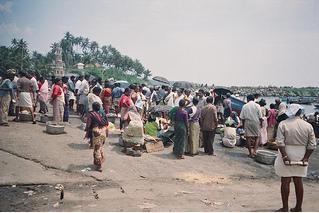
Activity at the fish market (Photo: Aarti Kelkar - Khambete)
Patterns of ownership of fishing equipment
Ibrahim (1992) writes of six different patterns of ownership in traditional fishing based on three aspects, nature of ownership, status of the owner and the status of the non-owner. They include:
1. Individual ownership
• Owner worker: where the owner is also a worker
• Non-owner partner: the other person is not the owner, but a partner.
2. Individual ownership
• Owner worker: where owner is also the worker
• Non-owner labourer: the other person is not an owner, but a labourer
3. Individual Ownership
• Owner non-worker: the owner is not the worker
• Non owner labourer: the other person is a labourer
4. Collective ownership
• Owner workers: where the owner is also a worker
• Non- owner partners where the other person is not the owner, but a partner
5. Collective ownership
• Owner workers: where the owner is also a worker
• Non owner labourers: the other person is a labourer
6. Collective ownership
• Owner non-workers: the owner is not the worker
• Non-owner labourers: the other person is a labourer
However, many of the fishermen in the traditional sector do not own fishing equipment and are referred to as employees or ‘coolies’ (Aerthayil, 2000)
The system of distribution of the catch
Ibrahim (1992) gives a detailed picture of the system of distribution among the fisherfolk of Kerala. He informs that the distribution of earnings is done on a share basis in case of all types of fishing. The norms for this system of distribution have been evolved historically and differ according to the participant’s relationship with each other, with the type of crafts and gear used and the type of fishing.
Thus, in case of the individual ownership and with canoe and net fishing, the total catch from a particular unit is divided into ‘n+1’ shares where ‘n’ is the crew size. Thus, one share also goes to the owner of the craft. In case the owner works on the craft, he gets two shares. There is no share for the ownership of the gear. However, in case of the hook and line fishing, the fishing gear is very expensive and the total catch is divided by ‘n+2’ shares. The owner gets two shares, one for the craft and one for the gear. One can see that in the individual ownerships, the owner gets an additional share of the catch.
In case of the collective ownership however, the share each individual receives of the catch is determined by his contribution to the total investment. In case of combined fishing, where different units work together on one fishing expedition, the catch is equally divided among different units. Each of the units then distribute the catch among its crew. However, in spite of the status of the fishermen, type of fishing, the area as well as the type of activity, all the members are entitled to a small quantity of fish i.e. 3 to 4 Kgs for home consumption. In some cases, units who fail to catch fish for the day also borrow from another unit (Ibrahim, 1992). Thus, in this traditional pattern of sharing, all the fishermen are assured of a daily supply of fish for their families.

Fishermen sorting their catch for the day (Photo: Aarti Kelkar-Khambete)
Role of women in fishing
Women play a very important role in all the fishing activities right from the period of harvesting. In the preharvest period, women in the marine sector are involved in making and mending nets, preparing hooks and baits. During the harvest season women spend a lot of time in activities such as netting in the estuaries, in clam and mussel picking, collecting seaweed and also pearl diving in a few cases (Nayak and Vijayan, 1996). There is a strong sexual division of labour within the fishing community. Women are in general not allowed to participate in the actual fishing activities involving going out to the sea and their activities are usually restricted to the domestic sphere.
All other fish related activities such as drying, peeling of fish are carried out by the women within their domestic spheres of activities. It is a very common sight to see women working in groups near to their houses in a typical fishing village. The job of fish trading is usually carried out by the older women among the fishing community, but younger women are not allowed to work as fish traders (Ram, 1991). Majority of the women participating in the fishing activities come from the Christian and Hindu communities. Very few Muslim women are seen participating in the fishing activities (Dietrich and Nayak, 2002).
Vijayan (1996) writes of the double burden of work that the fisherwomen have to face in their everyday lives where they have to take care of the household and childrearing activities as well as participate in fish related occupations such as net making, fish vending and net processing. Fish harvesting is followed by the processing of fish. This involves a range of activities from unloading the fish to sorting, icing, curing and drying of fish, peeling of prawns and oil extraction. All these activities are carried out by women who form a majority of the work force. Kurien (1985) writes of the deplorable conditions of the women and children working in this unorganised sector who are paid very less and who have to work under extremely poor conditions and are exploited in the peeling shed units of Kerala and also other States such as Gujarat and Orissa.
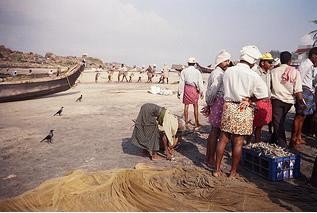
A fisherwoman at the fish market (Photo: Aarti Kelkar- Khambete)
Vijayan and Nayak (1996) inform that the drying of fish was one of the most important activities carried out by the coastal communities since a long time. All the fish that could not be sold were thus, dried. Fish was dried in a variety of ways such as sun drying for small varieties of fish and cleaning, filleting, salting and drying for the larger varieties. When there were large amounts of fish, they were buried deep into the ground along with salt and then taken out and dried. Drying of fish had largely been a home based enterprise till recently. Now, this has become a mini industry with women being hired by fish merchants who buy fish on a large scale. Now it is not only the women from the coastal communities who work here, but women from other sectors such as the agricultural sector seeking work also work here.
Recently, huge machines for fish drying are also being used. This commercialisation has on one hand led to increased employment opportunities for the women in the fishing sector, but on the other, has also led to increasing competition for work, loss of the local monopoly of the fishing women in the activities that were done at the household level. This has also led to the transfer of control in the hands of the bigger markets and merchants who decide the use of the fish and control the processing mechanisms for the fish (Vijayan and Nayak, 1996). The third stage in the fishing process includes the marketing of the fish. Marketing forms almost a quarter of the work force in the fishing sector. Marketing is largely carried out by men in the northern and the central parts of Kerala. However, elderly women work as head load fish vendors and sell fish to the local population, in the south (Aerthayil, 2000).
Vijayan et al (1996) writes of the fish vending women in Trivandrum district, where a large number of women go for fish vending because of the presence of a large number of artisenal fishermen. The fishermen leave early in the morning in search of fish while the women wait on the beach for their arrival. It is the women who participate in the auction. The market area is also full of other merchants with bicycles, tempos and vans who compete with the women to buy fish. With recent changes in technology and with increasing mechanisation in fishing, it is becoming increasingly difficult for the women to handle the marketing of fish as marketing has become a huge affair with intense competition. The fishermen are also found to prefer to sell fish to the big merchants who have ready cash to pay to the fishermen.
Thus, mechanisation and commercialisation of fishing has led to decrease in the availability of fish as well as created problems for the fish vending women by destroying their traditional economy of fishing in the village. Hapke (2001) writes that commercialisation of fishing has helped in increasing the prices of fish and also helped some fishing communities to prosper. However, it has also led to the marginalisation of the women in the fishing industry.
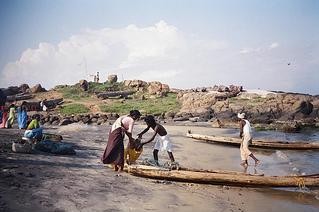 Fisherwoman buying fish (Photo: Aarti Kelkar - Khambete)
Fisherwoman buying fish (Photo: Aarti Kelkar - Khambete)
Mechanisation in fishing
The modernisation of fisheries was started by the government in the 1950s, write Kurien and Sebastian (1982). Before this initiative, fishing was a caste based artisenal activity that used variety of fishing technologies such as crafts and gears according to the local needs. The first phase took place in the form of the Indo-Norwegian project. This project originally aimed at community development and proposed the introduction of small mechanised boats and the construction of harbours in a few villages.
However, after the 1960s, the main focus of the project shifted with an increasing demand for prawns for export markets. Thus, large trawl boats started to be used for harvesting prawns. By the 1970s, the mechanised fleet began to encroach on the territory of the traditional fishermen who continued their own way of fishing. Kurien and Sebastian (1982) argue that, this gradually has led to a gap between the traditional fishermen and the fishermen using newly mechanised fishing boats for prawn fishing. Mechanisation has gradually led to the deterioration of the economic condition of the traditional fishermen because of the huge gap between the two types of fishing. This has also led to a gradual decrease in fish quantities as well as changed the traditional patterns of fish drying, processing as well as marketing of fish and thus has gradually led to the marginalisation of the traditional fishing communities.
(The author is a public health researcher based in Trivandrum, and works with the India Water Portal)
Part I of this article on the life and the socioreligious organisation of the fisherfolk of Kerala can be found at this link
References:
Aerthayil, M. (2000) Chapter II: The background of Kerala. In: Fishworker’s Movement in Kerala (1977-1994)- The Role of Non-Party Political organisations in Social Transformation in India. New Delhi, Indian Social Institute. p 13-21
Aerthayil, M. (2000) Chapter III: The Traditional Fishworkers of Kerala. In: Fishworker’s Movement in Kerala (1977-1994)- The Role of Non-Party Political Organisations in Social Transformation in India. New Delhi, Indian Social Institute. p 22-34.
Bhushan, B. (1979) Technological change in fishing in Kerala (1957-1977). Mphil Thesis. Centre for Development Studies, Trivandrum, Kerala.
Hapke, H.M. (2001) Development, Gender and Household Survival in a Kerala Fishery. Economic and Political Weekly, March 31, 2001, 1103-1107.
Hapke, H.M. (2001) Development, Gender and Household Survival in a Kerala Fishery. Economic and Political Weekly, March 31, 1103-1107.
Hapke, H.M. (2001) Gender, Work and Household Survival in South Indian Fishing Communities: A Preliminary Analysis. The Professional Geographer, 53(3), 313-331.
Houtart and Nayak (1988) Chapter I: Challenges of a culture in transition. In: Kerala Fishermen: Culture and Social Organisation. Centre D’ Analyse Sociale. De La Culture (Centre Tricnontinental). Lovaine- la-Neuve, Belgium. p 1-18.
Ibrahim, P. (1992) Chapter 3: Mode of production on the eve of mechanisation. In:Fisheries developement in India. New Delhi, Classical publishing company. p 30-44.
Iyengar, V. (1985) Fisherpeople of Kerala: A plea for rational growth. Economic and Political Weekly. Vol XX(49), 2149-2153.
Kurien, J. (2001) The Socio-Cultural Aspects Of Fisheries: Implications For Food And Livelihood Security: A case study of Kerala state, India. In: Goodwin, J.R.M. (ed) Understanding the cultures of fishing communities: A key to fisheries management and food security. FAO Fisheries Technical Paper 401. p 196-217.
Kurien, J. and Sebastian,M. (1982) Technological change in fishing: its impact on the fishermen. ICSSR, New Delhi.
Kurien, J.(1985) Technical Assistance Projects and Socio-economic Intervention in Kerala’s Fisheries Development. Economic and Political Weekly, XX(25 and 26),
Kurien, J.(1985) Technology, Credit and Indebtness in Marine Fishing: A Case Study of 3 villages in South India. XX(40), 1680-1690.
Nayak, N. (1986) Impact of the changing pattern of fish vending by women in the fishing community. Trivandrum, Fisheries Research Cell, PCO centre.
Nayak, N. and Vijayan, A. () The role and the plight of women in fisheries. In: Women for sustainable fisheries: Report of the first phase of women in fisheries programme of ICSF. Women in fisheries, number 3, Samudra Dossier. p 29-37.
Ram, K. (1991) Chapter 3: Popular religion and femininity (1): the disciplining of the female body in popular Catholicism. In: Mukkuvar Women: Gender, hegemony and Capitalist Transformation in a South India Fishing Community. Sydney, Allen and Unwin Private limited. p 45-112.
Ram, K. (1991) Chapter 9: Sexual codification of women’s work: domesticity and female proletarianisation in the Mukkuvar community. In: Mukkuvar Women: Gender, hegemony and Capitalist Transformation in a South India Fishing Community. Sydney, Allen and Unwin Private limited. p 200-229.
Srivastava (1985) Chapter 9 Fishing gear and conventional fishing methods. In: A textbook of fishery science and Indian fisheries. Allahabad, Kitab Mahal. p 153-167.
Vijayan, A. (1996) Part II: Health and Reproductive Rights of Women in Fishing Communities of Kerala. In: Women First: Report of the Women in Fisheries Programme of ICSF in India. Chennai, International Collective in Support of Fishworkers. p 70-77.
/articles/traditional-fisherfolk-kerala-part-ii-article-describing-economy-fishing-and-role-women